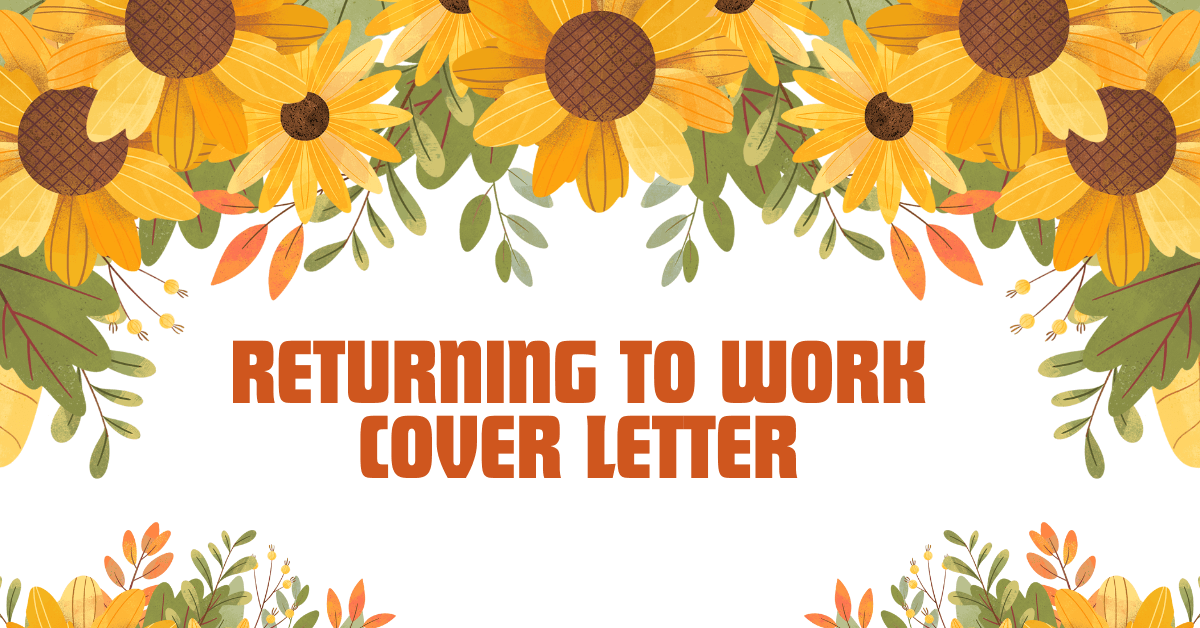Returning to work after a period of absence can be an exciting but daunting prospect. Whether you’re re-entering the workforce after a career break, maternity leave, or a sabbatical, crafting a compelling cover letter is crucial to showcase your skills and enthusiasm. In this blog post, we’ll delve into the art of writing a standout “returning to work cover letter” and provide practical strategies to help you make a successful comeback.
I’ve spent the past decade honing my writing skills, and I’ve had the privilege of helping countless individuals craft impactful cover letters that have landed them their dream jobs. I believe that a well-written cover letter is not merely a formality but an opportunity to demonstrate your unique value and passion for the role you’re applying for. In this article, I’ll share my insights and expertise to guide you in creating a cover letter that will leave a lasting impression on potential employers.
As you embark on this journey back to work, remember that you bring a wealth of experience and fresh perspectives to the table. Your time away from the traditional workforce has likely provided you with valuable life lessons, skills, and a renewed sense of purpose. Embrace this opportunity to showcase your resilience, adaptability, and the unique contributions you can make to any organization.

Sample of a Returning to Work Cover Letter
Dear [Hiring Manager Name],
I am writing to express my interest in the [Job Title] position at [Company Name]. I am a highly motivated and experienced professional with a proven track record of success in [Industry]. I am confident that I have the skills and experience necessary to excel in this role.
After taking a [Number] month break from work to focus on [Purpose of Break], I am eager to return to the workforce and contribute my talents to a dynamic organization. During my break, I engaged in [Activities or Learning] that have enhanced my knowledge and skills.
In my previous role at [Previous Company Name], I was responsible for [List of Responsibilities]. I consistently exceeded expectations, delivering exceptional results. I am proficient in [List of Skills], and I am confident that I can leverage these skills to make a significant contribution to your team.
I am a results-oriented individual with a strong work ethic. I am also a team player and I am always willing to go the extra mile. I am confident that I can be a valuable asset to your organization.
Thank you for your time and consideration. I look forward to the opportunity to discuss my qualifications further and demonstrate how I can contribute to the success of [Company Name].
Sincerely,
[Your Name]
How to Write a Returning to Work Cover Letter
1. Start with a strong opening paragraph
Your opening paragraph should immediately grab the reader’s attention and make them want to learn more about you. Start with a strong statement or anecdote that highlights your skills and experience. For example, you could say something like, “I am writing to express my interest in returning to work as a [position name] at [company name]. I have been away from the workforce for [number] years, but I am confident that my skills and experience make me an ideal candidate for this role.”
2. Highlight your skills and experience
The next section of your cover letter should focus on highlighting your skills and experience. Be specific and provide examples of your accomplishments. For example, you could say something like, “In my previous role as a [position name] at [company name], I was responsible for [list of responsibilities]. I successfully [list of accomplishments]. I am confident that I can use my skills and experience to make a significant contribution to your company.”
3. Explain your reason for returning to work
In this section, you should explain your reason for returning to work. Be honest and upfront about your situation. For example, you could say something like, “I am returning to work because I am looking for a new challenge. I have been a stay-at-home parent for the past [number] years, and I am now ready to get back into the workforce. I am confident that my skills and experience make me an ideal candidate for this role.”
4. Express your enthusiasm for the position
In the final section of your cover letter, you should express your enthusiasm for the position. Let the reader know why you are interested in working for their company and why you believe you are the best candidate for the job. For example, you could say something like, “I am excited about the opportunity to work for [company name]. I am impressed by your company’s commitment to [company values]. I believe that my skills and experience would be a valuable asset to your team.”
5. Close with a strong call to action
Your closing paragraph should be a strong call to action. Tell the reader what you want them to do, such as schedule an interview or visit your website. For example, you could say something like, “I would welcome the opportunity to discuss my qualifications further. I am available for an interview at your earliest convenience. Thank you for your time and consideration.”
Tips about a Returning to Work Cover Letter
Returning to work after a break can be daunting, but it’s important to put your best foot forward when applying for jobs. A well-written cover letter can make all the difference, so here are seven tips to help you write a standout letter:
-
Highlight your skills and experience.
Make sure to highlight the skills and experience that are most relevant to the job you’re applying for. Use specific examples to demonstrate your abilities, and quantify your accomplishments whenever possible.
-
Explain your career break.
If you took a break from work, be sure to explain why in your cover letter. Keep it brief and professional, and focus on how your break has made you a stronger candidate.
-
Show your enthusiasm.
Let the employer know that you’re excited about the opportunity to return to work. Express your enthusiasm for the company and the position, and explain why you’re the best person for the job.
-
Keep it concise.
Your cover letter should be no more than one page long. Get to the point quickly and avoid unnecessary details.
-
Proofread carefully.
Before you submit your cover letter, proofread it carefully for any errors. Make sure there are no typos or grammatical mistakes.
-
Use a professional format.
Use a standard font and font size, and make sure your letter is well-spaced and easy to read.
-
Tailor your letter to each job.
Don’t send out the same cover letter for every job you apply for. Take the time to tailor your letter to each specific position, highlighting the skills and experience that are most relevant to the job.
By following these tips, you can write a cover letter that will help you stand out from the competition and land the job you want.
FAQs about a Returning to Work Cover Letter

How do I write a cover letter for returning to work after a break?
Start by introducing yourself and stating the position you are applying for. Briefly explain your career break and how it has helped you develop new skills or perspectives. Highlight your relevant experience and skills, and explain how they align with the requirements of the job. Conclude by expressing your enthusiasm for the opportunity and your confidence that you can make a valuable contribution to the company.
What should I include in my cover letter?
Your cover letter should include your contact information, the date, the name and address of the hiring manager, a salutation, an introduction, a body paragraph highlighting your skills and experience, a body paragraph explaining your career break, a body paragraph expressing your interest in the position, a closing paragraph, and your signature.
How do I format my cover letter?
Your cover letter should be formatted in a professional font, such as Times New Roman, Arial, or Calibri. It should be single-spaced, with one-inch margins on all sides. Your contact information should be placed at the top of the letter, followed by the date, the hiring manager’s name and address, and the salutation.
What is the best way to end my cover letter?
The best way to end your cover letter is with a strong closing paragraph. This paragraph should reiterate your interest in the position and your confidence that you can be a valuable asset to the company. You should also thank the hiring manager for their time and consideration.
What are some common mistakes to avoid when writing a cover letter?
Some common mistakes to avoid when writing a cover letter include: using a generic template, failing to tailor your letter to the specific job you are applying for, making grammatical or spelling errors, and being overly negative or self-deprecating.
RELATED:
Late Pick up Letter to Parents
Renters Insurance Letter to Tenant
